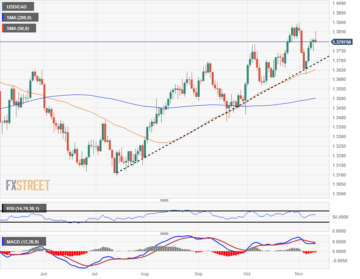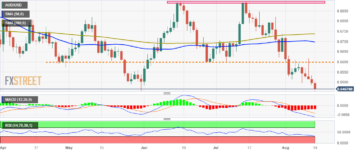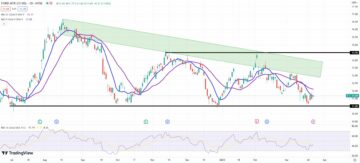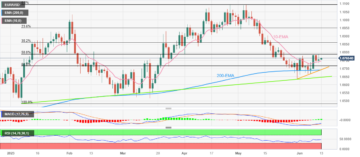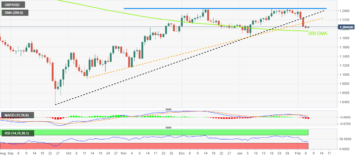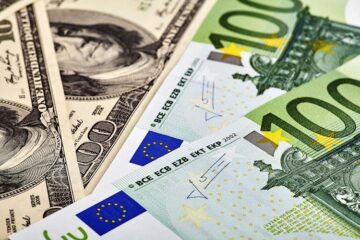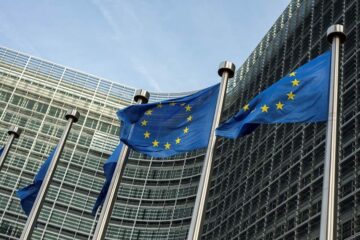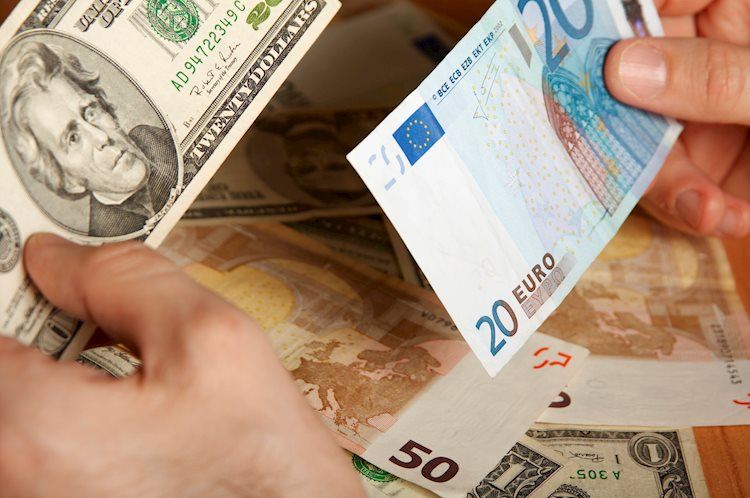
- EUR/USD edges lower for the second straight day and is pressured by a combination of factors.
- Rising bets for an on-hold decision by the ECB in September continue to undermine the Euro.
- The uncertainty over the Fed’s future rate-hike path benefits the USD and weighs on the major.
The EUR/USD pair remains on the defensive for the second successive day on Friday and trades below mid-1.0800s, representing the 200-hour Simple Moving Average (SMA) through the Asian session. The fundamental backdrop, meanwhile, favours bearish traders and supports prospects for an extension of the overnight sharp retracement slide from the vicinity of a two-and-half-week top, around the 1.0945 region touched on Wednesday.
The shared currency is weighed down by cautious comments by European Central Bank (ECB) officials on Thursday, which lifted bets for an on-hold decision at the September policy meeting. In fact, Isabel Schnabel, who is considered one of the most hawkish members of the ECB, noted that Euro Zone growth was weaker than predicted, though that does not necessarily void the need for more rate hikes. Adding to this, ECB Vice-President Luis de Guindos said that the central bank is nearing the end of its hiking rate cycle but the decision on whether to further tighten its monetary policy at its next meeting in two weeks is still open for debate.
This comes on the back of the Euro Zone data showing a moderation in underlying price growth in August and boosts expectations that the ECB will keep interest rates unchanged. According to the official figures released by Eurostat, the annual Euro Zone Harmonised Index of Consumer Prices (HICP) held steady at 5.3% in August against the 5.1% expected. The Core HICP, however, eased to 5.3% YoY in August from 5.5% in the previous month, matching consensus estimates. In contrast, inflation in the US, as measured by the change in the Personal Consumption Expenditures (PCE) Price Index, rose to 3.3% YoY in July from the 3% previous.
Furthermore, the annual Core PCE Price Index – the Federal Reserve’s preferred gauge of inflation – rose 4.2%, a slightly stronger pace than the 4.1% increase recorded in June. Additional details of the report showed that Personal Income grew 0.2%, while Personal Spending rose 0.8% on a monthly basis – the strongest print since January. The data keeps the door for one more 25 bps Fed rate hike move by the end of this year, which assists the US Treasury bond yields to stall the recent pullback from a multi-year peak. This, in turn, underpins the US Dollar and supports prospects for a further depreciating move for the EUR/USD pair.
That said, other data released earlier this week – the ADP report and the second estimate of the US Q2 GDP print – indicated that the resilient US economy has already started losing steam. This might force the Fed to soften its hawkish stance, which, in turn, is holding back the USD bulls from placing aggressive bets and limiting the downside for the EUR/USD pair. Market participants also seem reluctant and prefer to wait on the sidelines ahead of the closely-watched US monthly jobs data. The popularly known NFP report is due for release later during the early North American session and provides some meaningful impetus to the major.
Technical level to watch
- SEO Powered Content & PR Distribution. Get Amplified Today.
- PlatoData.Network Vertical Generative Ai. Empower Yourself. Access Here.
- PlatoAiStream. Web3 Intelligence. Knowledge Amplified. Access Here.
- PlatoESG. Automotive / EVs, Carbon, CleanTech, Energy, Environment, Solar, Waste Management. Access Here.
- PlatoHealth. Biotech and Clinical Trials Intelligence. Access Here.
- ChartPrime. Elevate your Trading Game with ChartPrime. Access Here.
- BlockOffsets. Modernizing Environmental Offset Ownership. Access Here.
- Source: https://www.fxstreet.com/news/eur-usd-remains-depressed-blow-mid-10800s-seems-vulnerable-ahead-of-us-nfp-report-202309010103
- :has
- :is
- :not
- 1
- 2%
- 25
- a
- According
- adding
- Additional
- adp
- ADP report
- against
- aggressive
- ahead
- already
- also
- American
- an
- and
- annual
- around
- AS
- asian
- assists
- At
- AUGUST
- average
- back
- backdrop
- Bank
- basis
- bearish
- below
- benefits
- Bets
- blow
- bond
- Bond yields
- boosts
- Bulls
- but
- by
- cautious
- central
- Central Bank
- change
- combination
- comes
- comments
- Consensus
- considered
- consumer
- consumption
- continue
- contrast
- Core
- Currency
- cycle
- data
- day
- de
- debate
- decision
- defensive
- details
- does
- Dollar
- Door
- down
- downside
- due
- during
- Earlier
- Early
- ECB
- economy
- edges
- end
- estimate
- estimates
- EUR/USD
- Euro
- Euro Zone
- expectations
- expected
- extension
- fact
- factors
- Fed
- Federal
- federal reserve
- Figures
- For
- Force
- Friday
- from
- fundamental
- further
- future
- gauge
- GDP
- grew
- Growth
- Hawkish
- Held
- Hike
- Hikes
- hiking
- holding
- However
- HTTPS
- in
- Income
- Increase
- index
- indicated
- inflation
- interest
- ITS
- January
- Jobs
- jpg
- July
- june
- Keep
- known
- later
- Level
- Lifted
- limiting
- losing
- lower
- Luis de Guindos
- major
- Market
- matching
- meaningful
- Meanwhile
- measured
- meeting
- Members
- might
- moderation
- Monetary
- Monetary Policy
- Month
- monthly
- more
- most
- move
- moving
- moving average
- multi-year
- nearing
- necessarily
- Need
- next
- nfp
- North
- noted
- of
- official
- officials
- on
- ONE
- open
- Other
- over
- overnight
- Pace
- pair
- participants
- path
- pce
- Peak
- personal
- placing
- plato
- Plato Data Intelligence
- PlatoData
- policy
- predicted
- prefer
- preferred
- previous
- price
- Prices
- prospects
- provides
- pullback
- Q2
- Rate
- Rate Hike
- rate hikes
- recent
- recorded
- region
- release
- released
- remains
- report
- representing
- Reserve
- resilient
- retracement
- ROSE
- s
- Said
- Second
- seem
- seems
- September
- session
- shared
- sharp
- showed
- showing
- Simple
- since
- Slide
- SMA
- some
- Spending
- started
- steady
- Steam
- Still
- straight
- stronger
- Supports
- than
- that
- The
- the Fed
- this
- this week
- this year
- though?
- Through
- thursday
- tighten
- to
- top
- touched
- Traders
- trades
- treasury
- TURN
- two
- Uncertainty
- underlying
- Undermine
- us
- US Dollar
- US economy
- us NFP
- US Treasury
- USD
- Vulnerable
- wait
- was
- Wednesday
- week
- Weeks
- weighs
- whether
- which
- while
- WHO
- will
- year
- yields
- zephyrnet

